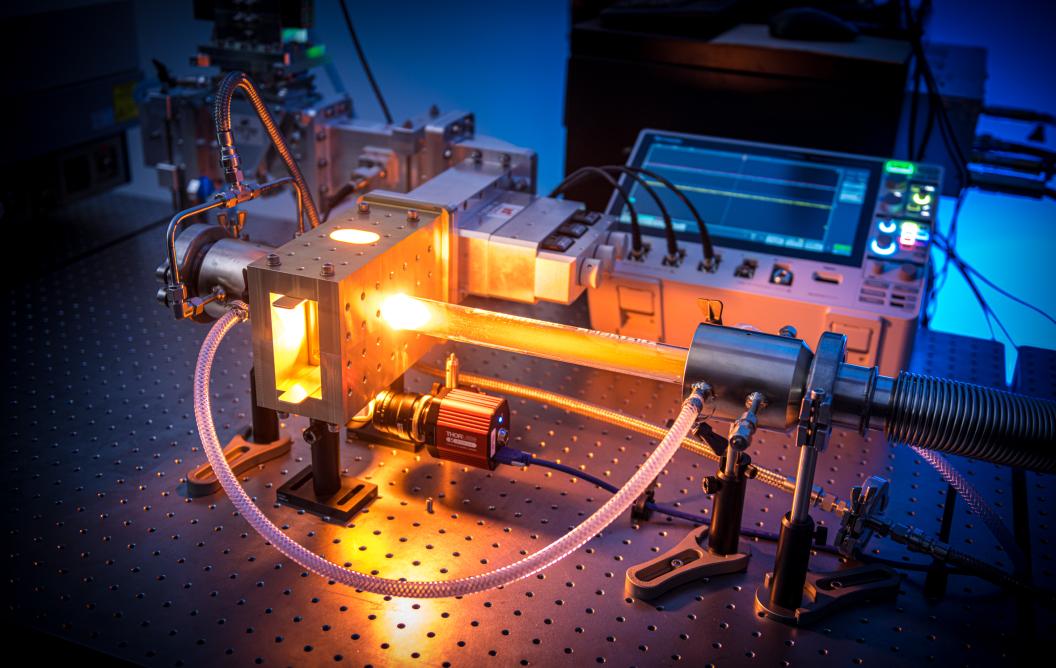Plasma reactors produce greener hydrogen
Do you want to make chemistry more sustainable, for example, by using green hydrogen? Then compress the electrical energy from 2-3 large wind turbines and methane into a one-meter-long tube, and you’ll produce hydrogen and other feedstocks for the chemical industry, all without releasing any CO2. In the plasma laboratory at Maastricht University, Gerard van Rooij and his colleagues are getting this technology to work.
Text: Patrick Marx
The Circular Chemical Engineering research group at the Faculty of Science and Engineering is sharing in a €34.5 million grant awarded to the 58 partners of the HyPRO project by GroenvermogenNL in October. With contributions from partners TNO and Sitech at the Brightlands Chemelot Campus, the Limburg-based researchers have a budget of €5 million.
Hydrogen
HyPRO is researching the more sustainable production of hydrogen, an important feedstock for the chemical industry. Traditionally, the chemical industry extracts hydrogen (H2) from natural gas (methane, CH4), releasing carbon (C) as the greenhouse gas carbon dioxide, which we want to eliminate.
Plasma
Hydrogen can also be produced through the electrolysis of water using green electricity, where water is split into hydrogen and oxygen. “The technology used to make hydrogen by electrolysis is not yet mature and still too expensive because it requires a lot of costly renewable electricity. Much research is still needed before electrolysis can be scaled up to an efficient and cost-effective industrial scale. This upscaling is HyPRO’s main goal,” says Gerard van Rooij, professor of plasma chemistry at the Circular Chemical Engineering research group.
The development of green hydrogen production is time-sensitive. The chemical industry at sites like Chemelot, for example, aims to become greener by 2050. That is why van Rooij and his colleagues at HyPRO are looking at an alternative, quicker-to-realize route: producing hydrogen using plasma chemistry.
“With green electrical energy, we convert methane into a plasma at around 2000 °C. The CH4 molecule then breaks apart into its components, carbon and hydrogen,” explains van Rooij. “Real-time plasma research is our speciality. We are the only ones in the world who have managed to do this.” The professor shares his insights next to an experimental reactor, a thin glass tube in which a plasma glows like a light sabre from the movie Star Wars.
Plastics
“With plasma, it’s easy to extract hydrogen from methane, but you are left with pure carbon. On a large scale, that carbon has little value.” Van Rooij aims to make better use of the carbon, for example, as a feedstock for plastic production. “We can steer the plasma reaction so that, instead of carbon, ethene is produced. Ethene is the feedstock for polyethylene, the most commonly used plastic in the world. This route gives you less hydrogen, but in return, you get a valuable feedstock that is in high demand on a large scale.”

A plasma is a gas with freely moving electrons. You can create plasma by heating gas molecules. A small percentage of the gas molecules (red spheres in the figure) then release electrons (yellow spheres). When these electrons are exposed to microwave radiation, their temperature rises to 20,000 °C. The electrons transfer their energy to the neutral gas (blue spheres), heating it further to 2000 °C, causing the molecule to break down into fragments, such as carbon and hydrogen.
The formation of ethene in a plasma reactor is an extremely challenging task that the researchers have mastered. “Carbon and hydrogen can form all sorts of new molecules, depending on the temperature. For the formation of ethene, it is essential to cool the plasma to the right temperature within 100 microseconds.” To compare, blinking your eyes takes 1000 times longer.
Scaling up
The plasma reactor is far from the scale required for industrial production. The glass test reactor has a capacity of 10 kilowatts, which is roughly equivalent to 10 kitchen microwaves. Engineers at UM and its partners TNO and Sitech are finalising a larger model with a capacity of 50 kilowatts, while a 100-kilowatt microwave is on the way. “To be ready by 2050, we are not scaling up the test installation step by step, but simultaneously on multiple levels.”
At an industrial scale, a capacity of 10-50 megawatts is needed. “That’s the energy generated by 2-3 large wind turbines.” However, scaling up doesn’t necessarily mean growing in size. An industrial plasma reactor is a relatively small apparatus, essentially an oversized exhaust pipe including a muffler.
When thinking about the methane the researchers are using, you might immediately associate it with natural gas, which is still a fossil fuel. To become climate neutral, the researchers are targeting industrial waste streams for their technology, such as methane released from a naphtha cracker, from the chemical recycling of plastics, or from biogas production. “Without plasma technology, we would continue burning all this methane and emitting CO2. With plasma technology, it is used as a feedstock for plastics, making the system significantly more sustainable.”


